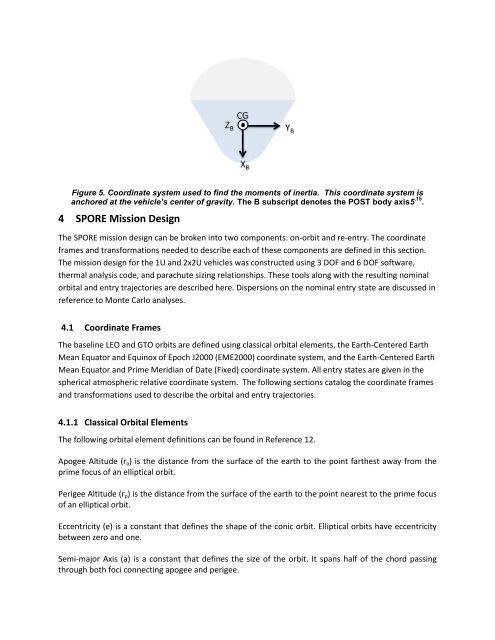SPORE Mission Design - Georgia Tech SSDL - Georgia Institute of ...
SPORE Mission Design - Georgia Tech SSDL - Georgia Institute of ...
SPORE Mission Design - Georgia Tech SSDL - Georgia Institute of ...
Create successful ePaper yourself
Turn your PDF publications into a flip-book with our unique Google optimized e-Paper software.
Figure 5. Coordinate system used to find the moments <strong>of</strong> inertia. This coordinate system is<br />
anchored at the vehicle’s center <strong>of</strong> gravity. The B subscript denotes the POST body axis5 ,15 .<br />
4 <strong>SPORE</strong> <strong>Mission</strong> <strong>Design</strong><br />
The <strong>SPORE</strong> mission design can be broken into two components: on-orbit and re-entry. The coordinate<br />
frames and transformations needed to describe each <strong>of</strong> these components are defined in this section.<br />
The mission design for the 1U and 2x2U vehicles was constructed using 3 DOF and 6 DOF s<strong>of</strong>tware,<br />
thermal analysis code, and parachute sizing relationships. These tools along with the resulting nominal<br />
orbital and entry trajectories are described here. Dispersions on the nominal entry state are discussed in<br />
reference to Monte Carlo analyses.<br />
4.1 Coordinate Frames<br />
The baseline LEO and GTO orbits are defined using classical orbital elements, the Earth-Centered Earth<br />
Mean Equator and Equinox <strong>of</strong> Epoch J2000 (EME2000) coordinate system, and the Earth-Centered Earth<br />
Mean Equator and Prime Meridian <strong>of</strong> Date (Fixed) coordinate system. All entry states are given in the<br />
spherical atmospheric relative coordinate system. The following sections catalog the coordinate frames<br />
and transformations used to describe the orbital and entry trajectories.<br />
4.1.1 Classical Orbital Elements<br />
The following orbital element definitions can be found in Reference 12.<br />
Apogee Altitude (r a ) is the distance from the surface <strong>of</strong> the earth to the point farthest away from the<br />
prime focus <strong>of</strong> an elliptical orbit.<br />
Perigee Altitude (r p ) is the distance from the surface <strong>of</strong> the earth to the point nearest to the prime focus<br />
<strong>of</strong> an elliptical orbit.<br />
Eccentricity (e) is a constant that defines the shape <strong>of</strong> the conic orbit. Elliptical orbits have eccentricity<br />
between zero and one.<br />
Semi-major Axis (a) is a constant that defines the size <strong>of</strong> the orbit. It spans half <strong>of</strong> the chord passing<br />
through both foci connecting apogee and perigee.
















